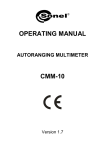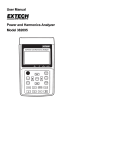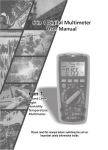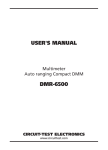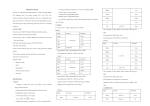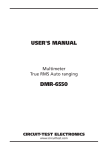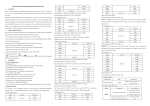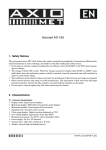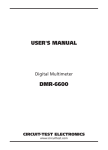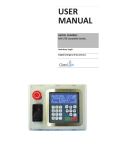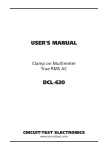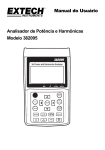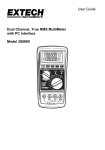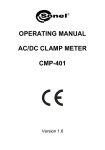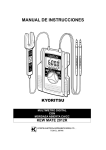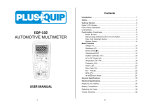Download Manual
Transcript
Autoranging True RMS Multimeter User Manual Please read this manual before switching the unit on. Important safety information inside. Autoranging True RMS Multimeter User Manual Autoranging True RMS Multimeter User Manual Contents Page 1. Safety Information.................................................................................4 2. Safety Symbols.....................................................................................5 3. Controls And Jacks............................................................................... 6 4. Symbols And Annunciators................................................................... 6 5. Specifications....................................................................................... 7 6. Operation.............................................................................................. 11 6-1. Non-Contact AC Voltage Measurements.......................................... 13 6-2. DC Voltage Measurements.............................................................. 13 6-3. AC Voltage Measurements.............................................................. 13 6-4. DC Current Measurements.............................................................. 14 6-5. AC Current Measurements.............................................................. 15 6-6. Resistance Measurements.............................................................. 15 6-7. Continuity Check.............................................................................16 6-8. Diode Test.......................................................................................16 6-9. Frequency Measurement................................................................. 16 6-10. Capacitance Measurements.......................................................... 17 6-11. Temperature Measurements.......................................................... 17 7. Replacing The Battery........................................................................... 17 8. Battery Installation................................................................................ 18 9. Replacing The Fuses............................................................................. 18 3 Autoranging True RMS Multimeter User Manual 1. Safety Information The following safety information must be observed to insure maximum personal safety during the operation at this meter: • Do not use the meter if the meter or test leads look damaged, or if you suspect • that the meter is not operating properly. • Never ground yourself when taking electrical measurements. Do not touch • exposed metal pipes, outlets, fixtures, etc., which might be at ground potential. • Keep your body isolated from ground by using dry clothing, rubber shoes, rubber • mats, or any approved insulating material. • Turn off power to the circuit under test before cutting, unsoldering, or breaking • the circuit. Small amounts of current can be dangerous. • Use caution when working above 60V dc or 30V ac rms. such voltages pose • a shock hazard. • When using the probes, keep your fingers behind the finger guards on the probes. • Measuring voltage which exceeds the limits of the multimeter may damage the • meter and expose the operator to a shock hazard. Always recognize the meter • voltage limits as stated on the front of the meter. • Never apply voltage or current to the meter that exceeds the specified maximum: Input Limits Function V DC or V AC mA DC/AC A DC/AC Frequency,Resistance, Capacitance, Duty Cycle, Diode test, Continuity Temperature 4 Maximum Input 600VDC, 600V AC 400mA DC/AC 10A DC/AC (30 seconds max every 15 minutes) 250V DC/AC 250V DC/AC Autoranging True RMS Multimeter User Manual 2. Safety Symbols • This symbol adjacent to another symbol, terminal or operating device indicates that the operator must refer to an explanation in the Operating Instructions to avoid personal injury or damage to the meter. WARNING • This WARNING symbol indicates a potentially hazardous situation, which if not avoided, could result in death or serious injury. CAUTION • This CAUTION symbol indicates a potentially hazardous situation, which if not avoided, may result damage to the product. MAX • This symbol advises the user that the terminal(s) so marked must not be connected to a circuit point at which the voltage with respect to earth ground exceeds (in this case) 500 VAC or VDC. • This symbol adjacent to one or more terminals identifies them as being associated with ranges that may, in normal use, be subjected to particularly hazardous voltages. For maximum safety, the meter and its test leads should not be handled when these terminals are energized. 5 Autoranging True RMS Multimeter User Manual 3. Controls And Jacks 1-4000 count Liquid Crystal 1-Display with symbolic signs 2-Function switch 3-10A (positive) input jack for 10A DC or AC measurements 4-COM (negative) input jack 5-Positive input jack 6-MODE pushbutton 7-Range pushbutton 8-Data Hold/Back Light 8-pushbutton 9-Relative pushbutton 10-Battery Cover 1 m 6 7 8 MODE Hz% 2 RANGE Auto Power Off V HOLD OFF CAP 10A REL 9 mA A Temp CAT III 600V 10A 3 V Temp Hz% mA A COM For 30sec. MAX every 15min FUSED 600V MAX 400mA MAX 5 4 10 4. Symbols And Annunciators BAT DATA HOLD AUTO AC DC 6 Continuity Low Battery Diode Data Hold AutoRanging Alternating Current or Voltage Direct Current or Voltage Autoranging True RMS Multimeter User Manual 5.Specifications The instrument complies with: Insulation: Overvoltage category: Display: EN61010-1. Class2, Double insulation. CATIII 600V. 4000 counts LCD display with function indication. Polarity: Automatic, (-) negative polarity indication. Overrange: “OL” mark indication. Low battery indication: The “BAT” is displayed when the battery voltage drops below the operating level. Measurement rate: 2 times per second, nominal. Auto power off: Meter automatically shuts down after approx. 30 minutes of inactivity. Operating environment: 0 °C to 50 °C (32 °F to 122 °F) at < 70 % relative humidity. Storage temperature: -20 °C to 60 °C (-4 °F to 140 °F) at < 80 % relative humidity. For inside use, max height: 2000m Pollution degree: 2 Power: One 9V battery , NEDA 1604, IEC 6F22. Dimensions: 138 (H) x 68 (W) x 37 (D) mm Weight: Approx.: 210g. Accuracy is given at 18 °C to 28 °C (65 °F to 83 °F), less than 70 % RH 7 Autoranging True RMS Multimeter User Manual DC Voltage (Auto-ranging) Range Resolution 400.0mV 0.1mV 4.000V 1mV 40.00V 10mV 400.0V 100mV 600V 1V Accuracy ±0.5% of rdg ± 2 dgts ±1.2% of rdg ± 2 dgts ±1.5% of rdg ± 2 dgts Input Impedance: 7.8MΩ. Maximum Input: 600V dc or 600V ac rms. AC Voltage (Auto-ranging except 400mV) Range Accuracy Resolution 400.0mV ±1.5%of rdg ± 40 dgts 0.1mV 4.000V ±1.2% of rdg ± 8dgts 1mV 40.00V ±1.5% of rdg ± 8 dgts 10mV 400.0V 100mV 600V ±2.0% of rdg ± 8 dgts 1V All AC Voltage ranges are specified from 5% of range to 100% of range Input Impedance: 7.8MΩ. Frequency Range:50 to 400Hz Maximum Input: 600V dc or 600V ac rms. DC Current (Auto-ranging for uA and mA) Range 400.0uA 4000uA 40.00mA 400.0mA 10A Resolution 0.1uA 1uA 10uA 100uA 10mA Accuracy ±1.0% of rdg ± 3 dgts ±1.5% of rdg ± 3 dgts ±2.5% of rdg ± 5 dgts Overload Protection: 0.5A / 250V and 10A / 250V Fuse. Maximum Input: 400mA dc or 400mA ac rms on uA / mA ranges, 10A dc or ac rms on 10A range. 8 Autoranging True RMS Multimeter User Manual AC Current (Auto-ranging for uA and mA) Range Accuracy Resolution 400.0uA ±1.5% of rdg ± 8 dgts 0.1uA 4000uA 1uA 40.00mA ±1.8% of rdg ± 8 dgts 10uA 400.0mA 100uA 10A ±3.0% of rdg ± 7 dgts 10mA All AC Voltage ranges are specified from 5% of range to 100% of range Overload Protection: 0.5A / 250V and 10A / 250V Fuse. Frequency Range: 50 to 400 Hz Maximum Input: 400mA dc or 400mA ac rms on uA / mA ranges, 10A dc or ac rms on 10A range. Resistance (Auto-ranging) Accuracy Range Resolution ±1.2% of rdg ± 4 dgts 400.0Ω 0.1Ω ±1.0% of rdg ± 2 dgts 4.000kΩ 1Ω 40.00kΩ 10Ω ±1.2% of rdg ± 2 dgts 400.0kΩ 100Ω 4.000MΩ 1kΩ ±2.0% of rdg ± 3 dgts 40.00MΩ 10kΩ Input Protection: 250V dc or 250V ac rms. Capacitance (Auto-ranging) Range Resolution 40.00nF 10pF 400.0nF 0.1nF 4.000uF 1nF 40.00uF 10nF 100.0uF 0.1uF Accuracy ±5.0% of rdg ± 7 dgts ±3.0% of rdg ± 5 dgts ±5.0% of rdg ± 5 dgts Input Protection: 250V dc or 250V ac rms. 9 Autoranging True RMS Multimeter User Manual Frequency (Auto-ranging) Range Resolution 5.000Hz 0.001Hz 50.00Hz 0.01Hz 500.0Hz 0.1Hz 5.000kHz 1Hz 50.00kHz 10Hz 500.0kHz 100Hz 5.000MHz 1kHz 10MHz 10kHz Sensitivity: >8V RMS Overload protection: 250V dc or ac rms. Accuracy ±1.5% of rdg ± 5 dgts ±1.2% of rdg ± 3 dgts ±1.5% of rdg ± 4 dgts Duty Cycle Range 0.1%~99.9% Resolution 0.1% Accuracy ±1.2% of rdg ± 2 dgts Pulse width: >100us, <100ms; Frequency width: 5Hz – 150kHz Sensitivity: >8V RMS Overload protection: 250V dc or ac rms. Temperature Range -20°C~+760°C -4°oF~+1400°F Resolution 1°C 1°F Sensor: Type K Thermocouple Overload protection: 250V dc or ac rms.. 10 Accuracy ±3% of rdg ±5°C/9°F Autoranging True RMS Multimeter User Manual Diode Test Test current 0.3mA typical Resolution 1 mV Accuracy ±10% of rdg ± 5 dgts Open circuit voltage: 1.5V dc typical Overload protection: 250V dc or ac rms. Audible continuity Audible threshold: Less than 150Ω Test current: <0.3mA Overload protection: 250V dc or ac rms. 6. Operation WARNING: Risk of electrocution. High-voltage circuits, both AC and DC, are very dangerous and should be measured with great care. • ALWAYS turn the function switch to the OFF position when the meter is not in • use. This meter has Auto OFF that automatically shuts the meter OFF if 30minutes • elapse between uses. • If “OL” appears in the display during a measurement, the value exceeds the range • you have selected. Change to a higher range. NOTE: On some low AC and DC voltage ranges, with the test leads not connected to a device, the display may show a random, changing reading. This is normal and is caused by the high-input sensitivity. The reading will stabilize and give a proper measurement when connected to a circuit. MODE BUTTON To select Ohm/Diode/Continuity/Cap , DC/AC, Hz/%Duty RANGE BUTTON When the meter is first turned on, it automatically goes into AutoRanging. This automatically selects the best range for the measurements being made and is generally the best mode for most measurements. For measurement situations requiring that a range be manually selected, perform the following: • Press the RANGE button. The “AUTO” display indicator will turn off. • Press the RANGE button to step through the available ranges until you select • the range you want. 11 Autoranging True RMS Multimeter User Manual • Press and hold the RANGE button for 2 seconds to exit the ManualRanging • mode and return to AutoRanging. DATA HOLD BUTTON The Data Hold function allows the meter to "freeze" a measurement for later reference. • Press the DATA HOLD button to “freeze” the reading on the indicator. The indicator • “HOLD” will be appear in the display. • Press the DATA HOLD button to return to normal operation. BACKLIGHT Press and hold the HOLD key for >1 second to turn on or off the display backlight function. Note: The HOLD feature will activate when the Backlight is turned on. Press the HOLD key again to exit Hold. RELATIVE BUTTON The relative measurement feature allows you to make measurements relative to a stored reference value. A reference voltage, current, etc. can be stored and measurements made in comparison to that value. The displayed value is the difference between the reference value and the measured value. • Perform any measurement as described in the operating instructions. • Press the RELATIVE button to store the reading in the display and the "REL" • indicator will appear on the display. • The display will now indicate the difference between the stored value and the • measured value. • Press the RELATIVE button to return to normal operation. 12 Autoranging True RMS Multimeter User Manual 6-1. Non-Contact AC Voltage Measurements WARNING: Risk of Electrocution. Before use, always test the Voltage Detector on a known live circuit to verify proper operation • Touch the probe tip to the hot conductor or insert into the hot side of the electrical • outlet. • If AC voltage is present, the detector light will illuminate. NOTE: The conductors in electrical cord sets are often twisted. For best results, rub the probe tip along a length of the cord to assure placing the tip in close proximity to the live conductor. NOTE: The detector is designed with high sensitivity. Static electricity or other sources of energy may randomly trip the sensor. This is normal operation 6-2. DC Voltage Measurements CAUTION: Do not measure DC voltages if a motor on the circuit is being switched ON or OFF. Large voltage surges may occur that can damage the meter. • Set the function switch to the V DC position . • Insert the black test lead banana plug into the negative (COM) jack and the red • test lead banana plug into the positive (V) jack. • Touch the test probe tips to the circuit under test. Be sure to observe the correct • polarity (red lead to positive, black lead to negative). • Read the voltage in the display. The display will indicate the proper decimal point • and value. If the polarity is reversed, the display will show (-) minus before the • value. 6-3. AC Voltage Measurements WARNING: Risk of Electrocution. The probe tips may not be long enough to contact the live par ts inside some 240V outlets for appliances because the contacts are recessed deep in the outlets. As a result, the reading may show 0 volts when the outlet actually has voltage on it. Make sure the probe tips are touching the metal contacts inside the outlet before assuming that no voltage is present. 13 Autoranging True RMS Multimeter User Manual CAUTION: Do not measure AC voltages if a motor on the circuit is being switched ON or OFF. Large voltage surges may occur that can damage the meter. • Set the function switch to the V AC position. • Insert the black test lead banana plug into the negative (COM) jack and the red • test lead banana plug into the positive (V) jack. • Touch the test probe tips to the circuit under test. • Read the voltage in the display. The display will indicate the proper decimal point, • value and symbol (AC, V, etc.). 6-4. DC Current Measurements CAUTION: Do not make current measurements on the 10A scale for longer than 30 seconds. Exceeding 30 seconds may cause damage to the meter and/or the test leads. • Insert the black test lead banana plug into the negative (COM) jack. • For current measurements up to 4000uA DC, set the function switch to the uA • position and insert the red test lead banana plug into the (uA) jack. • For current measurements up to 400mA DC, set the function switch to the mA • range and insert the red test lead banana plug into the (mA) jack. • For current measurements up to 10A DC, set the function switch to the A position • and insert the red test lead banana plug into the 10A jack. • Press the AC/DC button until “DC” appears in the display. • Remove power from the circuit under test, then open up the circuit at the point • where you wish to measure current. • Touch the black test probe tip to the negative side of the circuit. Touch the red • test probe tip to the positive side of the circuit. • Apply power to the circuit. • Read the current in the display. The display will indicate the proper decimal point, • value and symbol. 14 Autoranging True RMS Multimeter User Manual 6-5. AC Current Measurements WARNING: To avoid electric shock, do not measure AC current on any circuit whose voltage exceeds 250V AC. CAUTION: Do not make current measurements on the 10A scale for longer than 30 seconds. Exceeding 30 seconds may cause damage to the meter and/or the test leads. • Insert the black test lead banana plug into the negative (COM) jack. • For current measurements up to 4000uA AC, set the function switch to the uA • position and insert the red test lead banana plug into the (uA) jack. • For current measurements up to 400mA AC, set the function switch to the mA • range and insert the red test lead banana plug into the (mA) jack. • For current measurements up to 10A AC, set the function switch to the A position • and insert the red test lead banana plug into the 10A jack. • Press the AC/DC button until “AC” appears in the display. • Remove power from the circuit under test, then open up the circuit at the point • where you wish to measure current. • Touch the black test probe tip to the negative side of the circuit. And touch the • red test probe tip to the positive side of the circuit. • Apply power to the circuit. • Read the current in the display. The display will indicate the proper decimal point, • value and symbol. 6-6. Resistance Measurements WARNING: To avoid electric shock, disconnect power to the unit under test and discharge all capacitors before taking any resistance measurements. Remove the batteries and unplug the line cords. • Set the function switch to the Ω cap position. • Insert the black test lead banana plug into the negative (COM) jack and the red • test lead banana plug into the positive Ω jack. • Touch the test probe tips across the circuit or part under test. It is best to • disconnect one side of the part under test so the rest of the circuit will not interfere • with the resistance reading. • Read the resistance in the display. The display will indicate the proper decimal • point, value and symbol. 15 Autoranging True RMS Multimeter User Manual 6-7. Continuity Check WARNING: To avoid electric shock, never measure continuity on circuits or wires that have voltage on them. • Set the function switch to the Ω cap position. • Insert the black lead banana plug into the negative (-) jack (COM) and the red • test lead banana plug into the positive (+) jack (Ω). • Press the MODE button until the symbol appears in the display. • Touch the test probe tips to the circuit or wire you wish to check. • If the resistance is less than approximately 150Ω, the audible signal will sound. • The display will also show the actual resistance. 6-8. Diode Test WARNING: To avoid electric shock, do not test any diode that has voltage on it. • Set the function switch to Ω cap position. • Press the MODE button until the symbol appears in the display. • Insert the black test lead banana plug into the negative (-) jack (COM) and the • red test lead banana plug into the positive (+) jack (Ω). • Touch the test probe tips to the diode or semiconductor junction you wish to test. • Note the meter reading • Reverse the probe polarity by switching probe position. Note this reading. • The diode or junction can be evaluated as follows: A. If one reading shows a value and the other reading shows OL, the diode is good. B. If both readings show OL, the device is open. C. If both readings are very small or 0, the device is shorted. NOTE: The value indicated in the display during the diode check is the forward voltage. 6-9. Frequency Measurement • Set the function switch to the FREQ position. • Insert the black test lead banana plug into the negative (-) jack (COM) and the • red test lead banana plug into the positive (+) jack (F). • Touch the test probe tips to the circuit under test. • Read the frequency in the display. The digital reading will indicate the proper • decimal point, symbols (Hz, kHz) and value. 16 Autoranging True RMS Multimeter User Manual 6-10. Capacitance Measurements WARNING: To avoid electric shock, disconnect power to the unit under test and discharge all capacitors before taking any capacitance measurements. Remove the batteries and unplug the line cords. • Set the function switch to the Ω CAP position. (“nF” and a small value • will appear in the display). • Insert the black test lead banana plug into the negative (-) jack (COM) and the • red test lead banana plug into the positive (+) jack (CAP). • Touch the test leads to the capacitor to be tested. The display will indicate the • proper decimal point, value and symbol. 6-11. Temperature Measurements WARNING: To avoid electric shock, disconnect both test probes from any source of voltage before making a temperature measurement. • Set the function switch to TEMP. • Insert the type K thermocouple probe black test lead banana plug into the negative • COM jack and the red test lead banana plug into the positive Temp jack. • Touch the Temperature Probe head to the part whose temperature you wish to • measure. Keep the probe touching the part under test until the reading stabilizes • (about 30 seconds). • Read the temperature in the display. The digital reading will indicate the proper • decimal point and value. • When setting "Celsius" or "Fahrenheit" into initial state, please remove the battery • cover and slip the “˚C/˚F " switch to the corresponding position. WARNING: To avoid electric shock, be sure the thermocouple has been removed before changing to another measurement function. 7. Replacing The Battery WARNING: To avoid electric shock, disconnect the test leads from any source of voltage before removing the battery door. • When the batteries become exhausted or drop below the operating voltage, “BAT” • will appear in the right-hand side of the LCD display. The battery should be replaced. • Follow instructions for installing battery. See the Battery Installation section • of this manual. 17 Autoranging True RMS Multimeter User Manual • Dispose of the old battery properly. WARNING: To avoid electric shock, do not operate your meter until the battery door is in place and fastened securely. 8. Battery Installation WARNING: To avoid electric shock, disconnect the test leads from any source of voltage before removing the battery door. • Disconnect the test leads from the meter. • Open the battery door by loosening the screw using a Phillips head screwdriver. • Insert the battery into battery holder, observing the correct polarity. • Put the battery door back in place. Secure with the two screws. WARNING: To avoid electric shock, do not operate the meter until the battery door is in place and fastened securely. NOTE: If your meter does not work properly, check the fuses and battery to make sure that they are still good and that they are properly inserted. 9. Replacing The Fuses WARNING: To avoid electric shock, disconnect the test leads from any source of voltage before removing the fuse door. • Disconnect the test leads from the meter and any item under test. • Open the fuse door by loosening the screw on the door using a Phillips head • screwdriver. • Remove the old fuse from its holder by gently pulling it out. • Install the new fuse into the holder. • Always use a fuse of the proper size and value (0.5A/250V fast blow for the • 400mA range, 10A/250V fast blow for the 10A range). • Put the fuse door back in place. Insert the screw and tighten it securely. WARNING: To avoid electric shock, do not operate your meter until the fuse door is in place and fastened securely. 18 Autoranging True RMS Multimeter User Manual Rev.130614 Autoranging True RMS Multimeter User Manual





















